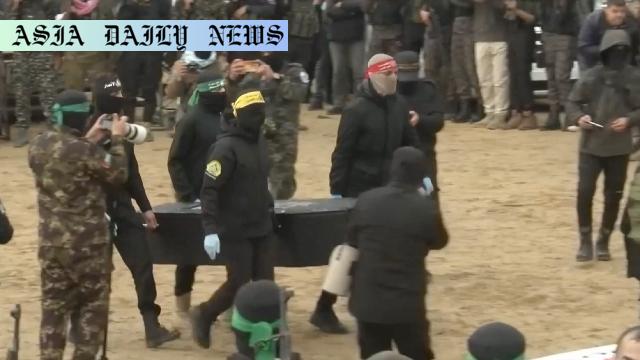Hostages – Hamas returned the bodies of a mother, her two children, and an elderly man, advancing terms of a fragile ceasefire.
- Hamas returned the bodies of four hostages, including children, as part of a ceasefire agreement with Israel.
- This brings the total confirmed number of released hostages to 23, with six more living hostages expected on Saturday.
- The long-term ceasefire and full release of hostages face significant challenges, with talks yielding minimal progress.
- Prime Minister Netanyahu aims to extend the 42-day ceasefire phase beyond its March 1 deadline.

Introduction: A Fragile Ceasefire
The ongoing conflict between Israel and Hamas took a somber turn on Thursday when Hamas returned the bodies of four Israeli hostages, including a mother, her two children, and an elderly man. This handover is part of a six-week ceasefire agreement that began on January 19, aiming to alleviate the human toll of the conflict. However, the situation highlights the fragile nature of ceasefires in highly tense regions, and raises questions about the feasibility of achieving lasting peace.
The Current State of the Hostage Exchange
Under the terms of the current agreement, Hamas has committed to returning 33 hostages it captured in October 2023. So far, 23 of these individuals have been confirmed as returned, with six living hostages expected to be released on Saturday. In exchange, Israel has released over 1,100 Palestinian prisoners, demonstrating a mutually fraught process of negotiation. The delicate steps in this exchange underscore the deep divisions between the two sides, even as temporary agreements are implemented.
Human Cost and Emotional Burden
The return of the bodies of a mother and her children stands as a grim reminder of the devastating human cost of the conflict. For families of hostages, the hope of reunion often turns into heartbreak with the return of lifeless bodies. Such events exacerbate existing emotional scars and highlight the need for a more permanent solution to halt the cycle of violence. The grieving process is compounded by the fact that many hostages remain unaccounted for, leaving families in perpetual limbo.
Challenges in Transitioning to the Second Phase
The ceasefire’s first phase, while a temporary reprieve, has not yet paved the way for substantive discussions on a permanent truce. Talks aimed at transitioning to a second phase—focused on a lasting ceasefire and the release of remaining hostages—have yielded little progress. Both sides remain entrenched in their positions, with negotiations stalling over key issues like territorial disputes and political demands.
Political Implications and Netanyahu’s Strategy
Israeli Prime Minister Benjamin Netanyahu has expressed a desire to extend the current ceasefire phase beyond its March 1 deadline. His strategy aims to prioritize the return of hostages without committing to a broader permanent ceasefire. However, this approach has drawn criticism both domestically and internationally, as it leaves the larger conflict unresolved while prolonging uncertainty for affected families. The risk of the ceasefire collapsing and a return to heightened violence looms over these strategic decisions.
Conclusion: A Path Forward
While the release of hostages signals a degree of cooperation, the road to peace remains fraught with obstacles. The ongoing hostage exchanges serve as a temporary salve rather than a lasting solution. Both Israel and Hamas must address the root causes of their conflict and engage in meaningful dialogue if long-term peace is to be achieved. Until then, the region remains trapped in a cycle of ceasefires and escalations, with its people bearing the brunt of the unrest.



Commentary
The Tragic Reality of Hostage Exchanges
The recent return of hostages, particularly the bodies of children and their mother, strikes a deeply emotional chord. Moments like these underscore the brutal realities that families endure during conflicts. For those who had clung to the hope of a joyous reunion, the delivery of lifeless bodies is a tragedy almost too immense to fathom. It is a stark reminder of the human cost hidden behind political agendas and territorial disputes.
Uncertainty in Negotiations
As negotiations continue, it becomes clear that any resolution between Israel and Hamas will not come easily. The lack of meaningful progress in transitioning to a permanent ceasefire signals deep-seated mistrust and divergent priorities. This stagnation not only delays peace but also prolongs the anguish of families eagerly awaiting the return of their loved ones. Each day without a resolution is another day enshrouded in uncertainty and fear.
Hope Amidst Adversity
Despite the bleakness, there remain glimmers of hope. The ongoing exchanges, while imperfect, show that dialogue is possible even in the most dire circumstances. It provides a foundation for further negotiation and highlights the potential for humanity to shine through the fog of conflict. However, sustained commitment and genuine efforts from both sides will be required to build upon these initial steps and strive for an enduring peace.
A Call for Renewed Effort
It is imperative that global leaders and organizations reinforce mediation efforts to break the cycle of violence. The future of countless families hangs in the balance as the world witnesses the tragedy unfolding. International support, coupled with unwavering dedication from the conflicting parties, remains the most viable path forward. Without it, the mournful stories of lost lives will continue to overshadow the possibility of reconciliation.